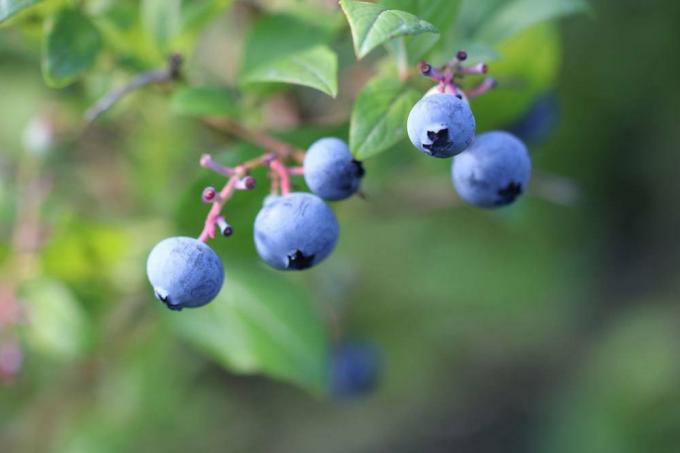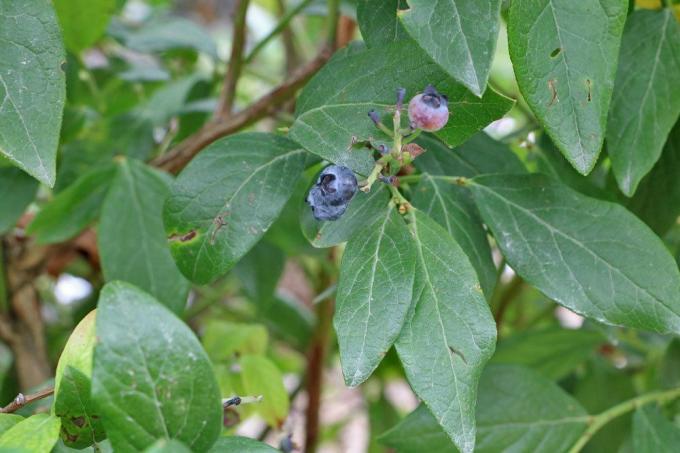
table of contents
- Plant blueberries
- Wild blueberries
- Cultivated blueberries
- Location
- floor
- Plant spacing
- Cultivation in rows or beds
- Blueberries in the bucket culture
Blackberries, cider berries or blueberries, the blueberry (Vaccinium myrtillus) has many names and is one of the most popular berries for snacking. Compared to other soft fruit bushes, however, it is less common in gardens, which is partly due to its demands on location and substrate. The advantage of cultivated blueberries is that cultivation has resulted in varieties that have different requirements and thus still deliver a good yield under difficult conditions.
Plant blueberries
Wild blueberries
In terms of their requirements, the cultivated and wild forms differ primarily in their locations. The wild Vaccinium myrtillus prefers shady to partially shaded locations. They tend to avoid direct sun, as they depend on rainwater in their natural environment and shade protects the soil from drying out quickly. When planting a wild blueberry, these requirements should always be taken into account. It is therefore often planted as a ground cover in more shady locations, as it gets along very well with it compared to other plants.

One advantage of wild blueberries is that they do not need a great deal of space compared to cultivated forms. In the forest they grow close together, but in your own garden you should make sure that there is 15-20 cm space between the individual perennials. Especially if they are not only decorative ground cover, but also have to provide yield. In addition, the wild blueberries need a very nutrient-rich soil, which means that they not only benefit from the harvest turns out better, but the plants can easily reach a height of up to half a meter can.
Cultivated blueberries
Location
Although the yield of wild blueberries is quite acceptable given good site conditions, cultivated varieties not only bring significantly more yield, the harvest is easier due to the fruit size. In terms of location, cultivars differ significantly from their wild relatives, because they prefer sunny locations. They can tolerate a maximum of a little shade per day, but then slightly lower yields can be expected. Sunny south-facing sides that are protected from the wind are ideal. A location on a sunny house wall is also ideal and favors an earlier harvest. A sunny and warm place can also help the berries taste better.
When growing cultivated blueberries, attention should also be paid to a protected place, because cultivated forms also like slightly damp locations. Wind ensures that the soil dries out more quickly, and if the substrate is too dry, then not only does the harvest fail, in an emergency the plants even shed their leaves early. However, if you don't have a choice of where to plant, you should use the perennials water regularly.
Alternatively, the ground can be covered with bark mulch in an unfavorable place. It ensures that the soil does not dry out too quickly and the rotting brings nutrients into the earth.
floor
Soils rich in limestone are not ideal conditions for blueberries. This not only affects their growth, the taste also suffers. If you have such conditions in the garden, you don't have to do without blueberries, the effort involved in planting is just greater. In the case of lime-rich soils large planting holes be excavated. Then the floor is prepared with a layer of potsherds or expanded clay. With blueberries, you should avoid gravel, as it is often too calcareous.
In order to prevent lime from getting into the planting hole via seepage water or groundwater, it can also be lined with a sturdy plastic film. To prevent waterlogging, holes are cut in the bottom of the film so that the water can drain off. There is no need to cut the foil on the sides of the planting hole.

Note: If there is too much lime in the soil, the blueberries usually indicate this by a yellow color on the leaves. Problems with a lime-rich soil can thus be clearly distinguished from the reddish autumn colors of the plants.
What cultivated blueberries have in common with the wild form is their predilection for acidic soils. The pH value of normal garden soil is slightly acidic at most, but blueberries need a soil with a value of 3.5 to 4.5. If the substrate is not acidic enough, you should exchange it again. Potting soil is ideal for bog beds or rhododendron soil, which has an acidic pH value. In order to keep the pH value constant, acidic soil should be worked in regularly. Mulching with bark mulch also favors a constant acidic pH value of the substrate.
Blueberries live in symbiosis with mycorrhizal fungi, which favor their development. The mycorrhizal fungi need bark compost or at least bark mulch to survive. When planting, you can already add bark compost to the soil and a layer of mulch provides additional replenishment due to the constant rotting. The pH value in the soil remains constant if you provide the blueberries with bark mulch once a year.
Plant spacing
If you want to grow cultivated blueberries, you have to ensure that there is sufficient space between the plants. Compared to their wild relatives, high-yield cultivated forms of blueberries can reach a height of up to two meters. As shallow roots, the perennials need a correspondingly large amount of space to spread out. There should be a minimum distance of 1.5 meters between the plants. This distance should also be kept to other soft fruit varieties or walls. This allows the roots to spread well and the plant can absorb sufficient nutrients. You can only reduce the distance to one meter with a weakly growing variety such as "Sunshine Blue".
tip: The location of the blueberries should generally be free of other plants. You should avoid growing ground cover. Weeds should be removed through regular weeding. Alternatively, you can cover the soil with bark mulch.
Cultivation in rows or beds
Although blueberries self-fruiting we recommend planting at least one additional perennial. As a rule, the yields are higher. You can plant the blueberries either in rows or in your own perennial beds. In a row crop, you only have to pay attention to a distance of 1.5 meters. In the case of a culture in beds or When growing in several parallel rows, a minimum distance of 2.5 meters must also be observed between the individual rows. This means that there is enough space for the roots of the plants to spread and harvesting is not made difficult by too high a density.
Blueberries in the bucket culture
Some blueberry varieties are also suitable for growing in a bucket. The advantage is that the choice of location is much easier in this case, as the bucket can also be set up on a sunny terrace sheltered from the wind. On the substrate or the condition of the soil does not have to be taken into account either, as a suitable substrate can be bought for the culture in the bucket.
Although only weakly growing dwarf varieties are suitable for a bucket culture, they need a minimum distance in the pot so that the roots can spread well. The bucket should therefore have a volume of at least 15 liters. So there is sufficient distance to the edge and the roots can develop both in depth and in width. For the substrate, you can again choose a soil for bog beds or rhododendron plants and mix it with bark compost.

For higher yields, you should again plant several plants in the tub and arrange them as a group or in a row. The following varieties are suitable for culture in the bucket:
- Top hat
- Coville
- jersey
- Spartan
A risk with pot culture is that the substrate is too moist or too dry. To prevent this, you should fill the bottom with a layer of coarse expanded clay. On the one hand, the clay balls can store water, which reduces the risk of dehydration, and on the other hand, they form a drainage layer that prevents waterlogging. You should also drill additional drainage holes so that rainwater can drain off better. A substrate mixed with a little sand ensures that the soil remains loose and permeable. Covering with bark mulch only protects the pot culture to a limited extent from drying out, but promotes an acidic pH value in the soil.
tip: If there is limited space in the garden, you can also plant weak-growing varieties outdoors. A minimum distance of a maximum of 70 cm outdoors is sufficient for varieties with poor growth.



